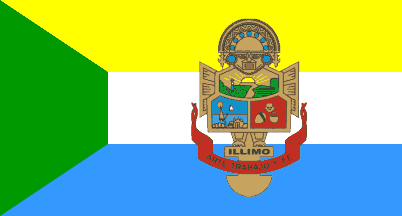
image by Zoltan Horvath, 05 May 2012

Last modified: 2021-08-25 by rob raeside
Keywords: illimo | lambayeque | peru |
Links: FOTW homepage |
search |
disclaimer and copyright |
write us |
mirrors

image by Zoltan Horvath, 05 May 2012
The District municipality of Íllimo (9,107 inhabitants in 2007; 6,730 ha),
founded on 22 November 1905 by Law No. 1936, is the capital of the Department of
Lambayeque, Region of Lambayeque.
Ivan Sache, 29 May 2010
The flag of Íllimo was selected on 26 October 2000 in a public contest. The text says that the flag is horizontally divided light blue-white-yellow with
a green trapeze along the hoist and the municpal emblem in the middle, while the
image shows the horizontal stripes in the reverse order, yellow-blue-light blue.
Blue symbolizes the sky, source of rain and life, as well as the aspirations of
the youth. White symbolizes peace and tranquillity granted by God for the
welfare of our society. Yellow symbolizes the potential treasures of the Huacas
and the soil, as well as the local gold shown in museums worldwide. Green
symbolizes agriculture, the main source of income of the population.
The trapeze symboizes the presence of our sacred huacas, the tombs of our former
rulers. [According to this explanation, the correct arrangement of the stripe
should be blue-white-yellow, with the sky on top and the soil on bottom.]
Source: Municipal website,
flag page.
The emblem of Íllimo, designed in 1986 by Marcial Anhuamán Castro, is made of a
shield hold by the Golden Tumi statuette, with a cartouche charged with the
black writing "ILLIMO" and a red scroll bearing the black writing "ARTE TRABAJO
Y FE" (Art, Work and Faith"). The shield is divided into three quarters. The
upper quarter shows a rural landscape divided into two parts by river La Leche.
On the left part is shown a farmer; on the right part, the same landscape is
dominated by an American carob tree; in the background is shown a Huaca pyramid
surmonted by the rising sun. The lower left quarter shows the village church,
hoisting a white gonfanon, here the banner of St. John the Baptist, the patron
saint; the star placed above the church is the Star of Betlehem, recalling the
local Three Kings' Festival. The lower right quarter represents the Lambayeque
culture, with three artefacts found in huacas.
Source: Municipal website,
emblem page.
The Íllimo Golden Tumi ("Tumi de Oro") (http://www.lambayeque.net/lambayeque/illimo/tumi-de-oro/) of was found in 1936-1937 in the Las Ventanas huaca by Dr. Julio César Tello - considered as the father of archeology
in Peru - and the local shepherd Hipólito Granados Durand. The statuette
(18-carat gold; 990 g; 43 cm x 15 cm) was used as a sacrificial knife in
religious ceremonies. Some scholars claim that the statuette represents God
Naymlap, the mythic stem of the rulers of the Lambayeque valley. The idol's face
is crowned by a semi-circular diadem included eight emeralds; two more, bigger
esmeralds represnets the ears. The face is covered by a mask typical of the
Lambayeque culture, ending, according to some scholars, in a bird's beak. The
lateral pendants also recall mythological birds. The figure stands on a golden
pedestal decorated with four esmeralds (replaced by the writing "ILLIMO" in the
coat of arms). The base of the idol is a half-moon shaped, sharpended piece.
Source:
Municipal website
Ivan Sache, 29 May 2010
The municipality has a new website:
Symbols (now on a single page) Now the written description matches the
image. However, I still have some doubt about the arrangement of the stripes,
since the upper stripe symbolizes the soil and the lower stripe symbolizes the
sky.
Ivan Sache, 05 May 2012
I was a bit doubtful about the website itself. While it does probably aim to
show the information, I don't think it's official. So I went looking for a
different one, and I found the new portal at the
old site.
The text accessed fro the new portal does indeed say explicitly that the yellow
field is on top, and shows this in the image as well. It then, however, explains
the colours in the exact opposite order, starting with the air at the bottom.
While the description and the image match, some doubt is indeed cast on the
proper order of the stripes.
Checking the
web archive, I find this inconsistency might be what confused us the first
time as well. So, checking for actual images, I find that we now have an
image of the flag in the cloth. Though it differs in not having the arms
throughout but rather on the middle stripe, it does indeed show the sky at the
bottom.
Peter Hans van den Muijzenberg, 05 May 2012
.gif)
image by Zoltan Horvath, 05 May 2012